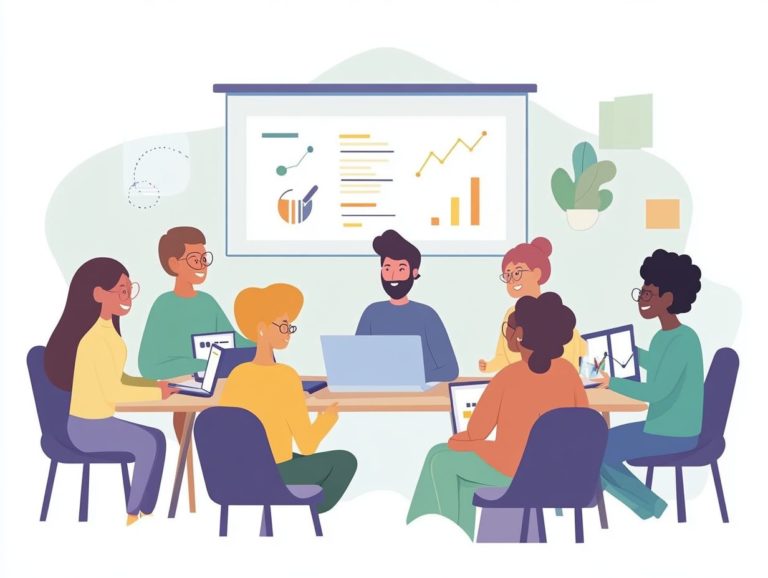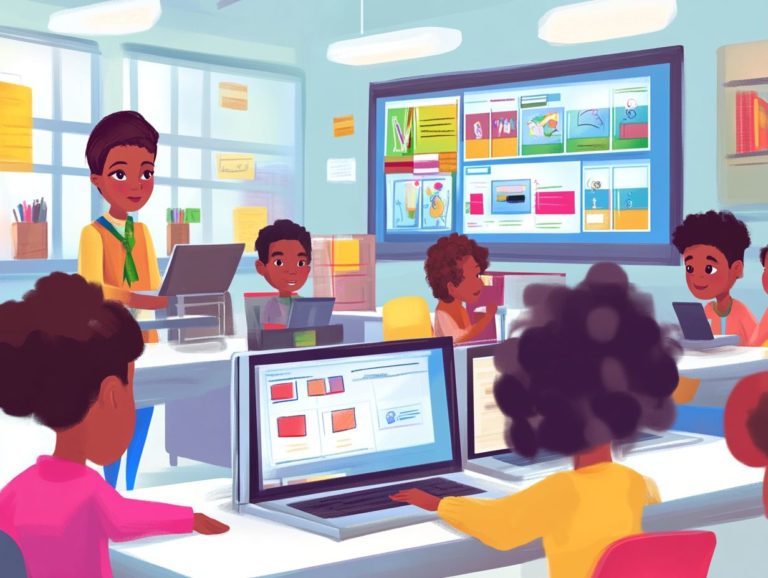Creating Engaging Content for E-Learning
In today s digital landscape, the success of eLearning relies on one crucial element: engaging content. As online education flourishes, it’s essential to captivate learners to achieve positive learning outcomes.
This article delves into the key components that create compelling eLearning experiences, exploring the impact of visuals, interactive activities, and real-world examples.
Get ready to uncover the best practices that will elevate your eLearning content, including effective storytelling techniques and strategies for measuring and enhancing engagement.
Join us as we unveil the secrets to crafting eLearning that resonates with learners and keeps them eager for more.
Contents
- Key Takeaways:
- Understanding the Importance of Engaging Content in eLearning
- Key Elements of Engaging Content
- Creating Engaging Content: Best Practices
- Assessing and Improving Engagement in E-Learning
- Frequently Asked Questions
- What does it mean to create engaging content for e-learning?
- Why is it important to create engaging content for e-learning?
- What are some key elements of engaging e-learning content?
- How can I make my e-learning content more interactive?
- What are some common mistakes to avoid when creating engaging e-learning content?
- How can I measure the effectiveness of my e-learning content?
Key Takeaways:

- Engaging content is crucial for successful eLearning, as it can greatly impact learning outcomes.
- The key elements of engaging content include visuals, interactive activities, and real-world examples.
- To create effective and engaging content, use storytelling techniques, gamification, and incorporate personalization and customization.
Understanding the Importance of Engaging Content in eLearning
Recognizing the significance of engaging content in eLearning is essential for addressing the varied preferences of learners, and implementing gamification strategies for e-learning engagement can play a key role in this process.
By embracing effective course design that prioritizes captivating courses, you transform learners from mere passive recipients of information into active participants in their educational journeys. This approach cultivates a lifelong passion for learning and amplifies the overall value of education.
Impact on Learning Outcomes
The impact of engaging content on learning outcomes is transformative, significantly enhancing engagement and retention rates. When course designers explore how to foster creativity in e-learning environments, they set the stage for a deeper understanding and better memory retention.
Interactive elements like quizzes and virtual simulations immerse learners in their educational journeys, leading to improved performance in assessments. Using a variety of instructional strategies such as gamification or case studies ensures different learning styles are accommodated, making the content more relatable and easier to grasp.
These approaches boost engagement and heighten the effectiveness of assessments, culminating in a more cohesive and rewarding learning experience.
Key Elements of Engaging Content
To craft engaging content in eLearning, consider several key elements that elevate the learning experience. This includes integrating visuals and multimedia, incorporating interactive activities, and employing storytelling techniques that resonate deeply with learners.
Visuals and Multimedia
Incorporating visuals and multimedia into your eLearning initiatives greatly enhances the user experience and elevates content delivery.
Different types of visuals such as infographics, charts, and videos engage learners by breaking down complex information into digestible formats. For instance, videos provide a visual demonstration of processes, making content accessible for those who may find text-heavy material daunting.
Animations and interactive elements like quizzes and simulations also elevate the learning journey by accommodating various preferences. This diverse range of multimedia keeps learners motivated and boosts information retention, encouraging course designers to prioritize these elements for a truly inclusive educational environment.
Interactive Activities

Interactive activities are essential for keeping you engaged and offering quick feedback throughout the eLearning process.
From quizzes and discussion forums to simulations and group projects, these activities significantly reinforce your learning goals. By immersing yourself in hands-on experiences, you deepen your understanding and cultivate a sense of ownership over your learning journey.
Incorporating instructional techniques like role-playing and peer teaching encourages you to actively participate and collaborate with others, sharing insights along the way. This collaborative environment enhances your autonomy, allowing you to explore topics more deeply.
This creates a vibrant educational experience that empowers you to excel!
Relevant and Real-World Examples
Incorporating relevant, real-world examples into your eLearning content effectively bridges the gap between theory and practical application for learners. This method clarifies complex concepts and fosters a deeper understanding by placing learning within familiar contexts.
When learners relate course material to their own experiences or situations they may face in their professional lives, it significantly enhances their motivation and retention. These examples accommodate diverse learning styles, ensuring that the content remains accessible and engaging for everyone.
By weaving practical scenarios into your lessons, you implement engagement strategies that truly resonate with individual preferences, maximizing the overall impact of the learning experience.
Creating Engaging Content: Best Practices
Creating engaging content requires you to embrace best practices that elevate the learning experience. This includes harnessing effective storytelling techniques, implementing gamification strategies which refers to using game-like elements in learning and personalizing your approach to meet the unique needs of each learner.
Effective Storytelling Techniques
Effective storytelling techniques, such as a compelling narrative structure and thoughtful character development, forge an emotional connection with you, significantly enhancing your engagement.
When you invest in a character s journey, you become more open to the lessons being conveyed. Using various narrative styles like linear, non-linear, or immersive storytelling caters to your unique learning preferences, ensuring that you feel included and valued in the process.
Well-crafted characters act as mirrors, reflecting your own experiences in their stories. Navigating challenges alongside these characters deepens the emotional resonance, creating a more memorable and impactful learning experience.
Utilizing Gamification
Utilizing gamification in eLearning transforms traditional learning into something truly engaging by incorporating competition and strategies that promote your autonomy as a learner.
When elements like points, badges, and leaderboards are seamlessly integrated into the course, they create a sense of achievement and recognition that resonates with you.
Points serve as a quick feedback mechanism, motivating you to actively progress through the material. Badges symbolize your accomplishments, allowing you to showcase your skills and dedication, enhancing your pride in the learning journey.
Leaderboards foster a friendly atmosphere of competition, encouraging you to improve while connecting with your peers. Together, these features elevate your motivation and cultivate a vibrant learning community, driving higher engagement throughout the course.
Dive into interactive learning today and discover exciting new ways to engage with your content!
Personalization and Customization

Personalization and customization of eLearning content are crucial for aligning with your preferences and maximizing course effectiveness.
By leveraging adaptive learning technologies, you can quickly create a learning experience that perfectly fits your unique needs! These are smart systems that adjust content based on how you learn, analyzing your interactions and performance data.
This tailored approach not only heightens your engagement but also elevates overall satisfaction. This makes you feel more connected and motivated.
Incorporating elements such as interactive quizzes, personalized feedback, and even gamified features can further enrich your learning journey. These features transform it into an enjoyable and effective experience for everyone involved.
Assessing and Improving Engagement in E-Learning
Assessing and enhancing engagement in eLearning is essential for maintaining the relevance and effectiveness of your content. To achieve this, you should implement strong feedback systems from learners and utilize effective assessment tools.
This approach ensures that your eLearning strategies are not only impactful but also aligned with the needs of your audience.
Measuring Engagement Levels
Measuring engagement levels in your eLearning courses can be achieved through a variety of assessment tools and analytics designed to track learner interactions.
Platforms like Learning Management Systems (LMS) provide valuable insights by gathering data on course completion rates, quiz performance, and the time spent on each module. With analytics platforms, you can explore learner behavior in greater depth, providing metrics such as login frequency and participation in discussions.
By leveraging these tools, you can effectively tailor your strategies to meet individual learner needs. Regularly analyzing this data allows for timely adjustments to content and delivery methods, ensuring they resonate more profoundly with your audience.
Strategies for Increasing Engagement
Are you ready to transform your learning journey? Implementing effective strategies to boost engagement in eLearning requires you to leverage instructional design principles that promote learner autonomy and utilize an active voice.
To truly captivate your audience, consider integrating interactive elements like quizzes, polls, and gamified activities. These tools encourage participants to immerse themselves in the material, making the learning experience more engaging.
Humor can also serve as a powerful ally, lightening the mood and transforming challenging content into a more enjoyable experience. This approach shatters barriers, making learning feel accessible and fun!
Fostering social interaction among learners through forums or group projects enhances collaboration and builds a supportive community. This not only promotes deeper understanding but also improves retention of the subject matter.
By adopting a holistic approach that considers all these elements, you can create a dynamic educational environment that truly resonates with your learners.
Frequently Asked Questions
What does it mean to create engaging content for e-learning?

Creating engaging content for e-learning refers to the process of developing educational materials that capture the attention and interest of online learners. This involves creating engaging skill enhancement content by using interactive and multimedia elements to make the learning experience more enjoyable.
Why is it important to create engaging content for e-learning?
Engaging content is crucial in e-learning because it keeps learners motivated and interested. For those involved in creating such content, understanding the key considerations for e-learning content development leads to better retention of information and can result in improved performance and outcomes.
What are some key elements of engaging e-learning content?
Engaging e-learning content includes interactive activities, multimedia like videos and audio, and small sections of information. For companies looking to enhance their training, customizing e-learning content incorporates these elements, giving learners chances to apply their knowledge.
How can I make my e-learning content more interactive?
Make your e-learning content interactive by adding quizzes and games. Incorporate discussion forums and real-life scenarios for problem-solving.
What are some common mistakes to avoid when creating engaging e-learning content?
Avoid using too much text and neglecting different learning styles. It’s vital to include enough interactive elements and refresh your content regularly to keep learners engaged.
How can I measure the effectiveness of my e-learning content?
Track learner engagement and participation to measure effectiveness. Conduct surveys or quizzes to assess knowledge retention and analyze performance outcomes for valuable insights.






